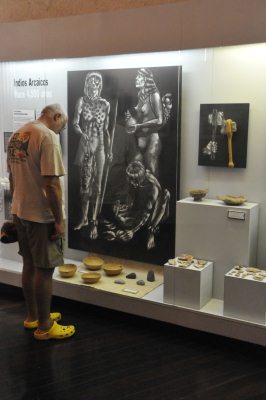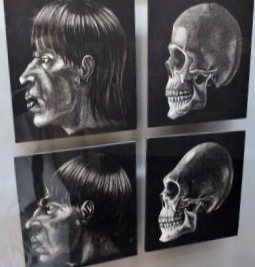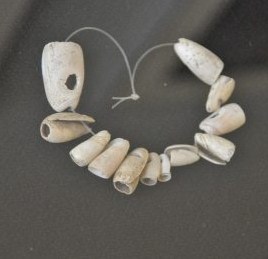Tibes

Beez Neez now Chy Whella
Big Bear and Pepe Millard
Mon 15 Feb 2010 23:36
|
Tibes Indigenous Ceremonial
Centre
    In 1975, tropical storm Eloisa hit
the city of Ponce and caused the River Portugues to overflow. When the
floodwaters subsided, they lay bare what was to become the Tibes Indigenous
Ceremonial Centre. Seven bateyes, two ceremonial plazas, burial grounds and many
artifacts were found on a private farm in Barrio (borough) Tibes. The Ponce
Municipal Government were persuaded to expropriate the farm to protect the
cultural heritage of the ancient people of Puerto Rico. A team of
archaeologists, historians, geologists and scholars surveyed the area and
analysed a vast amount of ceramic, lithic material and other remains found at
the site. They concluded that not one but two different cultures, the Igneri and
the Pre-Tainos populated the Valley of Tibes at different times.
  This image
represents the God, Guardian del Sur, the second is
Guardian del Aire
  We had a
look around the well laid out museum, then watched a
short film about the site, then met our guide for a tour of the site. Usually
closed on a Monday, except today a Bank Holiday
The Igneri
People
  The Shaman beginning the
ceremony and a man on the end of a pipe.
The "Cohoba" - Road to the Gods.
Sitting solemnly in a circle, the Indians surrender themselves to a strange
ritual in order to communicate with the gods. First, they cleansed their bodies.
This cleansing was done by vomiting by sticking a special spatula down their
throats. Then, they inhaled hallucinatory powders using wooden inhalators which
looked like a nose pipe. The powders were a mixture of cohoba seeds and crushed
shells. You put the pipe up one nose hole and your neighbour blew the mixture up
your nose with quite a bit of force. The Indians told Christopher Columbus, that
during one of their communications with the gods which could foresee the future,
they were told of an invasion of men wearing clothes. At the time they had
thought the gods meant the Caribes who they were at war with, until they met the
Spaniards. Inhalations ceremonies were performed before any major decision was
taken about harvests or going to war. The ceremony is still going well
today among the Amazon Indians and is called the Yopo ritual. As well as
inhaling cohoba, the Indians were habitual tobacco smokers using pipes, the
Spaniards believed their tobacco had hallucinatory effects.
  Preparing for a
ceremony. The shapes of the Igneri skull and the flattened Taino
skull.
The Igneri Culture: The Igneri or
Saladoids, were the first farmers and ceramists to settle in the West Indies.
They journeyed from the coasts of the Orinoco River in Venezuela and settled on
the various islands along the way. They finally arrived in Tibes at
around 300 AD. The Igneri settled near the coastlines and rivers
developing an advanced culture based on the cultivation of cassava and other New
World plants. An artistic contribution made by the igneris was pottery in the
shape of inverted bells, these were painted red and decorated in most cases with
white geometric designs. The peoples revered the Valley of Tibes, More than a
hundred human burials were found, some had pottery, seashells, food amulets
buried with them. This is widely regarded as evidence to show the Igneri
had a belief in a spiritual and supernatural world.
  A shaped stone could be a grinder, or the other way up a
tool for gardening etc
The Pre-Taino
People
The Pre-Tainos settled in the Valley
of Tibes hundreds of years later. They farmed, fished and hunted using the River
Baramaya - now called the River Portugues - as a source of food and
transportation. Small tools for personal use were made from seashells as well as
stones. Pre-Tainos constructed "Plazas" and "Bateyes" that characterises Tibes.
Within the plazas they played a ball game called batu, the ball was made
from resins, roots and leaves and weighed between nine and twenty pounds. There
were twenty five to thirty players on each team and the idea was to keep the
ball from touching the ground using any part of the body except the hands. It is
thought that outcome of the game decided the fate of Spanish prisoners and
generally had religious overtones. The court or playing areas were marked with
rows of stones.
Several times a year, Pre-Tainos
staged Areytos - ceremonies combining religious and educational elements.
Traditions, stories and beliefs were an intrinsic part of this festivity
that included music, dancing and singing. These events were great learning times
for the younger ones.
  Taino Indians had certain
recommendations in order to attain beauty and harmony, their tips were:
    This sequence of photos shows the steps followed by the Taino
Indians when making pottery. The artisan, Maria Cheverez, a native of
Morovis, used the original techniques. The first step was to make small
cylinders of wet clay. These would be placed one on top of the other to form the
body of the container. These cylinders were then smoothed using wet hands or or
a piece of wood or stone until the surface was soft and even. Once this was
achieved the decorating process would begin. Cutting the clay with a small stick
or a piece of bone. Then the container was burned by placing it in a hole in the
ground which was heated with charcoal and kindling.
   The finished pots, as found by the archeologists at the
site. The big flat dish was used for grinding cassava
etc, the small piece was decorative and the
odd shaped thing is a stool.
Anon -
Sweetsop, custard apple
Areyto - Celebration
ritual
Barbacoa -
Observation tower
Bija
- Red pigment
Boriken - Land of the High
Lord
Buren - Round
ceramic plate to cook casabe
Casabe
- Cassava bread
Coa
- Digging stick
Guanabana -
Soursop Some native words and their
meaning
Guasabara - Skirmish or
fight
Higuera
- Gourd to make utensils
Jicotea - Sea
turtle
Juracan
- Evil God
Maboya
- Bad Spirit
Quenepa
- Honeyberry
Tibes -
Stone river
Yukiyu - Supreme and
good deity
  This perfectly preserved skeleton was found during the dig
on the site, buried in the traditional fetal position.
 Walter, our very knowledgeable guide. He told us this site
had been used only for ceremonies and meetings as no evidence of a village has
ever been found
Indian
villages or "Yucayeques" were located in areas surrounded by dense tropical
vegetation and beautiful landscapes. In the centre of each was a "Batey" or
plaza similar to those seen in Spain. It was used for celebrations, ceremonies
and ball games. The Indians had two types of houses, one square - the other
round. The "Bohios" or huts could house one or more family. The largest Indian
village was estimated at around three thousand people. Each village had its own
chief "Cacique". Each village was also part of a district which was ruled by a
head chief. In contrast to other tribes the lineage was via the eldest child or
first born of the chief, male or female. When the old chief died, there was a
huge ceremony where the locals celebrated his or her life with alcoholic
beverages and stories led by the Shaman. The chief could have many wives, or
husbands in the case of a female chief, the first was buried with them. They
were given much stronger liquor during the feast of remembrance, until by
morning they were unconscious and easily covered by the burial party. This was
seen as a great honour. Sometimes food, jewelry or trinkets were put in the
grave. Some 157 graves were found on this site, many have been reburied, a few
have been taken to be studied.
  A typical pattern
of huts. The chiefs was in the centre of the
village and much larger and oblong, not circular, to accommodate his or her
large family.
The Indians called
Puerto Rico Boriken. When the Spaniards arrived, the most powerful chief was
Agueybana whose village was known as Guainia. The area was near the mouth of the
River Yauco. Agueybana's political district covered what is today Ponce and
extended beyond Cabo Rojo. Historians, however, believe that this chiefs
orders were obeyed throughout the island and most of Hispaniola - the
Dominican Republic.
 The
pitch for ball games
 The
ceremonial stones, have been proven to follow celestial
patterns.
 . . The huge plaza, where all
ceremonies and important occasions took place, the stones to the left mark the
graveyard.
ALL IN ALL AN AMAZING ACCIDENTAL
DISCOVERY
|